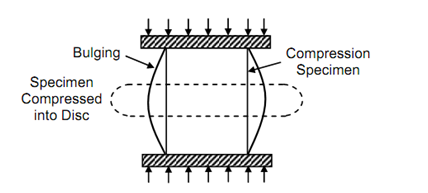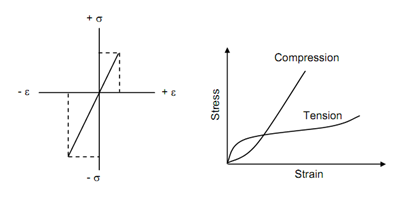Compression Test
There are several materials used in engineering practice that are primarily meant to carry compressive loads, concrete, bricks and wood are normally used in compression. Therefore, the mechanical properties of these materials are often evaluated in compression test. Generally, behaviours in tension and compressive are similar but there are differences in stress-strain diagram and mode of failure particularly in ductile materials which need understanding.
In a simple compression test cylindrical specimens of standard length to diameter ratios are compressed between two platens under axial load. The mechanical properties such like final compressive strength, yield strength, modulus of toughness and also elastic constant, modulus of elasticity may be determined for brittle materials in compression test. For a ductile material, however, the ultimate compressive strength cannot be defined because a ductile material keeps on expanding in lateral directions as compressive load increases. This lateral expansion continues to take place whereby area increases and ultimately the specimen might be turned into disc. This lateral bulging of a ductile material enables it to resist almost indefinitely large focus without fracture. The specimen in contact with platen expands less because of friction between surfaces of platens and specimen. Sometimes the stress for an arbitrarily chosen deformation is indicates as compressive strength of a ductile material. Often, the ability to undergo large plastic deformation under compression is called malleability of ductile materials but this property cannot be defined quantitatively. Modulus of elasticity and modulus of resilience for ductile material can be evaluated in compression as in tension but modulus of toughness cannot be defined.

Figure: A Ductile Material Specimen in Compression
At atomic level, unlike tensile stress case, no definite maximum exists in stress vs atomic bond curve and thus there is not limit to repulsive force that can be build up between atoms. Thus, the compression will not become the cause of failure and will always result in elastic strain. It is the shearing stress component which causes the slip of atomic planes and results in bulging of the specimen, and plastic deformation. With this consideration the stress-strain diagram within elastic limit will be the extension of that in tension with the difference that the elastic behaviour in compression ends a higher values of stress and strain as shown in Figure .

Figure : (a) Elastic Stress-Strain Relationship in Tension and Compression and
(b) Behaviour of Rubber in Tension and Compression
Long chain ploymeric materials like rubber, cork or wood show distinctly different behaviour in tension and compression. In tension the coiled molecules are first uncoiled and then strained whereby such materials show low stiffness followed by higher stiffness in tension. On the other hand compression may tend to cause further coiling in the initial stage followed by elastic compression of molecules showing slight stiffening effect in immediate decrease of stiffness. As the cells are compacted with increasing compressive load, the stiffness will further increase.